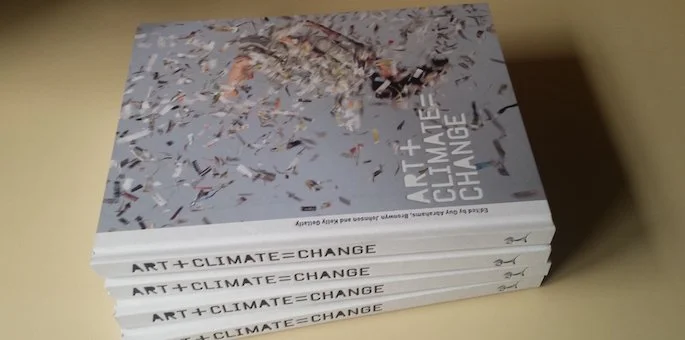Art + Climate = Change
Art + Climate=Change edited by Guy Abrahams, Bronwyn Johnson and Kelly Gellatly. Published 2016.
The Politics of Perception
Jasmine Targett and Debbie Symons
Latrobe Regional Gallery
Exhibition: 27 March - 24 May 2015
Forward
The Politics of Perception, an exhibition by Jasmine Targett and Debbie Symons uses strikingly beautiful media to encourage the onlooker to ponder the confronting themes of environmental degradation and global warming. Many would argue that science often has difficulty getting messages through regarding environmental concerns, and Targett and Symons bravely use their visually emotive works to bridge that gap, to give the viewer a different path to take in the journey towards discussion about climate change.
Latrobe Regional Gallery is delighted to be participating in Art+Climate=Change 2015. As a region with a strong power and agricultural industry, we are pleased to be able to provide an avenue for dialogue and discussion regarding moving towards a more sustainable future.
Shelley McDermot, Arts Director at Latrobe Regional Gallery.
The Politics of Perception
Latrobe Regional Gallery
East of Melbourne, nestled between the Strzelecki Ranges to the south and Baw Baw Ranges, part of the Great Dividing Range, to the north lies the region of the Latrobe Valley. A significant centre for Victoria’s energy industry, the Latrobe Valley is known for its mining and burning of brown coal to produce electricity; producing around 85% of Victoria’s entire electricity needs as well as supplying some of New South Wales and Tasmania’s power requirements; it is also home to four of the highest electricity producing thermal power stations in Australia. Apart from power generation, this region is known for its timber mills, paper manufacturing and dairy produce.
Set intriguingly against this backdrop of energy and forestry industries is the exhibition, The Politics of Perception, by artists Debbie Symons and Jasmine Targett, showing at Latrobe Regional Gallery, Morwell. This is important for an exhibition that aims ‘to raise awareness, create discourse and reflect on industry impacts.’ Perhaps more importantly however is the incongruity of such an exhibition in this region, and this juxtaposition drew Symons and Targett to work with the gallery. Their aim was to encourage people to reflect on climate and environmental issues such as ozone hole depletion, species loss and deforestation in the region, helping to bring it into the realm of mainstream consciousness.
Situated on the second floor of the gallery, the lighting in the exhibition space has been dimmed to maximize the effect of the digital projection on the far wall by Symons and the Perspex sculpture with reflective glass by Targett. Along the left side of the space sit three hand blown glass domes, a collaborative piece by Symons and Targett. This is a minimal exhibition with a lot to say.
Demanding the viewer’s attention on entrance, Blind Spot, (2014) by Jasmine Targett shimmers, its terraced curves of Perspex and glass capturing something that is both beautiful and yet ephemeral; a circular mirror attached to the ceiling above reflecting a foreshortened view of the object: encouraging, perhaps, the viewer to contemplate another way of seeing. One might become absorbed in the curves of the form or the luminescent qualities of the material until realizing that ‘like an iceberg looming in space’ it symbolizes something more ominous, the discovery of the Ozone Hole and the implications that posses to life as we know it. Like the story of the Emperor’s New Clothes, what we want to see is not the truth which confronts us.
A five minute video, Amazonia, (2015) by Symons ‘interrogates the inextricable links between environmental degradation and free market capitalism’ in the Amazon basin. On first viewing it might reflect something akin to an abstract painting in progress; strong blue lines dissecting the green of the picture plane that soon become layered with areas of ochre and varying tones of brown. On closer viewing however it becomes clear that this is a visual mapping that documents the clearing and over production of irreplaceable rainforest over a 40 year period. Text tallies run along the bottom, quantifying the amounts of coffee, soybeans, bananas, raw sugar and cotton crops, to name a few, that have been produced over this period. Along the right side, figures indicate the threat to mammal, non-mammal and plant species in this area. It is frightening and illuminating.
Antarctica: Dissolving Perception, (2009), collaboratively by Targett and Symons in finely blown glass, further examines the plight of Antarctica. The three eye-ball like glass dooms act as a microscope. The works narrative of past, present and forecast examine Antarctica; the dramatic reduction of ice in the Antarctic peninsula, the changes that have occurred throughout the region during three key Earth Summits, 1992, 1997 & 2002 and the forecast for no ice, should the environmental issues remain unresolved.
The works of these two artists’ form a strong symbiosis, each an interpretive element for the other, building greater depth and meaning; their full impact demanding time and effort from the viewer.
These finely produced works based on research and collaboration with both scientists and environmental data organizations make this an exhibition on which to ponder and will keep you pondering all the way back to Melbourne or further.
Mem Capp
Melbourne Artist and Writer. Artshub




